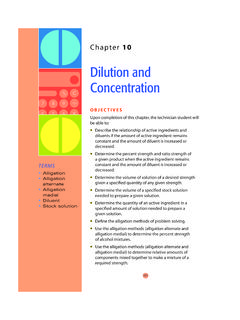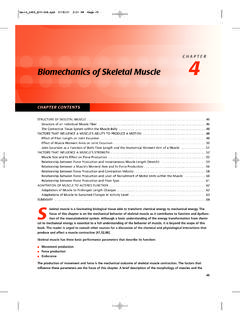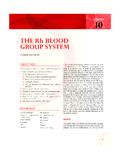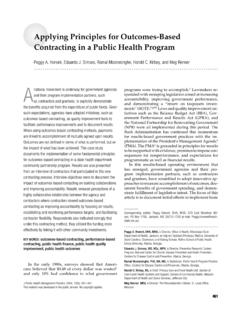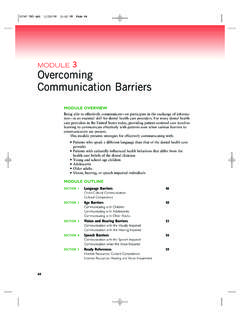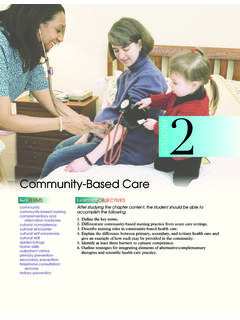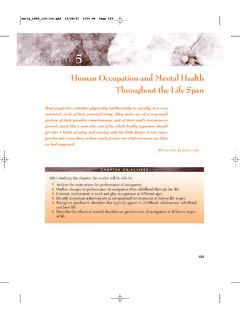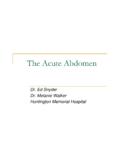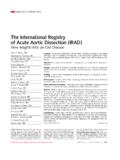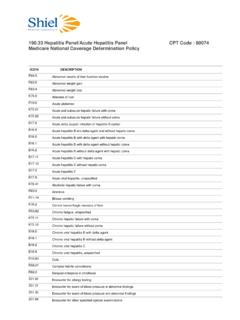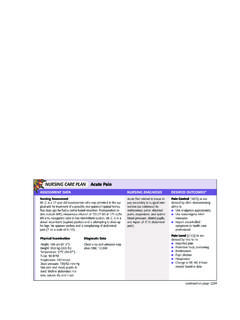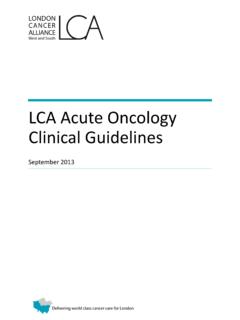Transcription of 11031-11 Ch11rev - Lippincott Williams & Wilkins
1 10 CHAPTER10 ANATOMY AND PHYSIOLOGYV isualize or palpate the landmarks of the abdominal wall and pelvis, as illus-trated. The rectus abdominis muscles become more prominent when thepatient raises the head and shoulders from the supine Abdomen11 CHAPTER11 CHAPTER 11 THE ABDOMEN415 Rectus abdominismuscleUmbilicusInguinal ligamentPubic tubercleXiphoid processCostal marginMidline, overlyinglinea albaAnterior superioriliac spineSymphysis pubisIliac crestFor descriptive purposes, the ab-domen is often divided by imaginarylines crossing at the umbilicus, form-ing the right upper, right lower, leftupper, and left lower system divides the abdomeninto nine sections. Terms for threeof them are commonly used: epi-gastric, umbilical, and hypogastricor examining the abdomen andmoving in a clockwise rotation, sev-eralorgans are often palpable.
2 Excep-tions are the stomach and much ofthe liver and spleen. The abdominalcavity extends up under the rib cageto the dome of the diaphragm, plac-ing these organs in a protected lo-cation, beyond the reach of thepalpating the right upper quadrant,the softconsistency of the livermakes it diffi-cult to feel through the abdominalwall. The lower margin of the liver,the liver edge, is often palpable at theright costal margin. The gallbladder,which rests against the inferior surfaceof the liver, and the more deeply lyingduodenumare generally not a deeper level, the lower pole of theright kidneymay be felt, especially inthin people with relaxed abdominalmuscles. Moving medially, the exam-iner encounters the rib cage, whichprotects the stomach; occasionallypatients misidentify the stony hardxiphoid processlying in the midline as atumor.
3 The abdominal aortaoftenhas visible pulsations and is usuallypalpable in the upper the left upper quadrant,the spleenis lateral to and behind the stomach,just above the left kidney in the left midaxillary line. Its upper margin restsagainst the dome of the 9th, 10th, and 11th ribs protectmost of the spleen. The tip of the spleen may be palpable below the leftcostal margin in a small percentage of adults. The pancreasin healthy peo-ple escapes the left lower quadrantyou can often feel thefirm, narrow, tubular sig-moid of the transverse and descending colon may also be pal-ANATOMY AND PHYSIOLOGY416 BATES GUIDE TO PHYSICAL EXAMINATION AND HISTORY TAKINGRUQLUQRLQLLQE pigastricUmbilicalHypogastricorsuprapubi cLiverLower pole ofright kidneyAscending colonCecumFull bladderXiphoidprocessAortaTransverse colonDescending andsigmoid colonIliac arteryGallbladderDuodenumSpleenStomachPa ncreaspable.
4 In the lower midline are the bladder,the sacral promontory,the bonyanterior edge of the S1 vertebra sometimes mistaken for a tumor, and inwomen, the uterusand the right lower quadrantare bowel loops and the appendixat the tail ofthe cecum near the junction of the small and large intestines. In healthypeople, there will be no palpable distended bladdermay be palpable above the symphysis pubis. The blad-der accommodates roughly 300 ml of urine filtered by the kidneys into therenal pelvis and the ureters. Bladder expansion stimulates contraction of blad-der smooth muscle, the detrusor muscle,at relatively low pressures. Risingpressure in the bladder triggers the conscious urge to intraurethral pressure can overcome rising pressures in the blad-der and prevent incontinence.
5 Intraurethral pressure is related to factors suchas smooth muscle tone in the internal urethral sphincter, the thickness ofthe urethral mucosa, and in women, sufficient support to the bladder andproximal urethra from pelvic muscles and ligaments to maintain properanatomical relationships. Striated muscle around the urethra can also contractvoluntarily to interrupt control of the bladder functions at several levels. In infants,the bladder empties by reflex mechanisms in the sacral spinal cord. Volun-tary control of the bladder depends on higher centers in the brain and onmotor and sensory pathways between the brain and the reflex arcs of thesacral spinal cord. When voiding is inconvenient, higher centers in the braincan inhibit detrusor contractions until the capacity of the bladder, approxi-mately 400 to 500 ml, is exceeded.
6 The integrity of the sacral nerves thatinnervate the bladder can be tested by assessing perirectal and perineal sen-sation in the S2, S3, and S4 dermatomes (see p. 702).The kidneysare posterior organs. The ribs protect their upper portions. Thecostovertebral angle the angle formed by the lower border of the 12th riband the transverse processes of the upper lumbar vertebrae defines theregion to assess for kidney AND PHYSIOLOGYCHAPTER 11 THE ABDOMEN417 CostovertebralangleKidney11th rib12th ribPOSTERIOR VIEWTHE HEALTH HISTORYEXAMPLES OF ABNORMALITIES418 BATES GUIDE TO PHYSICAL EXAMINATION AND HISTORY TAKINGG astrointestinal complaintsrank high among reasons for office and emergency-room visits.
7 You will encounter a wide variety of upper gastrointestinal symp-toms, including abdominal pain, heartburn, nausea and vomiting, difficultyor pain with swallowing, vomiting of stomach contents or blood, loss ofappetite, and jaundice. Abdominal pain alone accounted for more than 13 mil-lion office visits in 20041and 7 million emergency-room visits in complaints are also common: diarrhea, constipation, changein bowel habits, and blood in the stool, often described as either bright redor dark and symptoms also originate in the genitourinary tract:difficulty uri-nating, urgency and frequency, hesitancy and decreased stream in men, highurine volume, urinating at night, incontinence, blood in the urine, and flankpain and colic from renal stones or you will need to cluster several findings from both the patient s storyand your examination as you sort through various explanations for thepatient s symptoms.
8 Your skills in history-taking and examination will beneeded for sound clinical and Mechanisms of Abdominal exploring gastro-intestinal and genitourinary symptoms, review the mechanisms and clinicalpatterns of abdominal pain. Be familiar with three broad categories ofabdominal pain: Visceral painoccurs when hollow abdominal organs such as the intestineor biliary tree contract unusually forcefully or are distended or organs such as the liver can also become painful when their capsulesare stretched. Visceral pain may be difficult to localize. It is typically pal-pable near the midline at levels that vary according to the structureinvolved, as illustrated on the next Table 11-1 Abdominal Pain(pp.)
9 454 455)Visceral pain in the right upperquadrant may result from liverdistention against its capsule inalcoholic or Concerning SymptomsGastrointestinal Disorders Abdominal pain, acute and chronic Indigestion, nausea, vomiting including blood, loss of appetite, early satiety Dysphagia and/or odynophagia Change in bowel function Diarrhea, constipation JaundiceTHE HEALTH HISTORYU rinary and Renal Disorders Suprapubic pain Dysuria, urgency, or frequency Hesitancy, decreased stream inmales Polyuria or nocturia Urinary incontinence Hematuria Kidney or flank pain Ureteral colicTHE HEALTH HISTORYEXAMPLES OF ABNORMALITIESCHAPTER 11 THE ABDOMEN419 Visceral pain varies in quality and may be gnawing, burning.
10 Cramping,or aching. When it becomes severe, it may be associated with sweating,pallor, nausea, vomiting, and restlessness. Parietal painoriginates from inflammation in the parietal peritoneum. Itis a steady, aching pain that is usually more severe than visceral pain andmore precisely localized over the involved structure. It is typically aggra-vated by movement or coughing. Patients with this type of pain usuallyprefer to lie still. Referred painis felt in more distant sites, which are innervated at approx-imately the same spinal levels as the disordered structures. Referred painoften develops as the initial pain becomes more intense and thus seemsto radiate or travel from the initial site.
